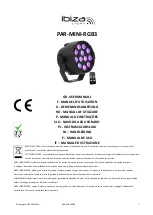
32
3
SAFETY PRECAUTIONS
id.:
DB 460 REV. 00 02/01/2015
The WORKING AREA is defi ned as the area in proximity of the vehicle where only persons that know its
operating capabilities may work.
The driver may operate only and exclusively when there is no one within the range of action. The driver must
warn anyone in the vicinity of the vehicle of the danger they are in by voice or sounding the horn.
If there is scaffolding or unstable structures near where you are working, keep at a safe distance so that you
do not risk touching these structures should you accidentally make an incorrect manoeuvre.
- Always check that there is no one in the vicinity of the vehicle before starting work.
- Before getting on the vehicle, walk around it once and check that everything is in order.
- Dust, smoke, fog, etc. may reduce your vision and cause accidents.
- Always stop or slow down until the impediment has been removed and you have perfect visibility of the
working area.
- If you cannot clearly see the entire working area, ask someone to guide you with hand signals and delimit
an area of over 12 metres for forward movement. This person must stand outside the working area and you
must be able to see him or her clearly.
- If working in the dark, carefully check the working area, turn on all the lights available and do not work in
areas where visibility is poor.
- Always make sure that you can clearly see the entire working or manoeuvring area.
- If the cabin has windows, they must always be kept clean and intact.
3.1.18 DANGEROUS WORKING CONDITIONS
3.1.19 WORKING AREA
3.1.20 VISIBILITY OF THE WORKING AREA
Before starting any operation, check that there are no dangerous working conditions in the surrounding area.
- Areas where there are slopes, humps, trees, demolished constructions, escarpments, gorges, tilled soil,
ditches, excavations, heavy traffi c, crowded parking and service areas and closed places are classifi ed as
risk areas.
- Check that there are no obstacles such as piping, cables, bottlenecks or loading limitations on the grounds,
bridges, pavements or access ramps.
- Establish the due safety measures to prevent danger on public roads in collaboration with the owners, users
and competent authorities.
- In places where there are underground water or gas pipes or high-voltage cable ducts, contact the public
utilities to fi nd out their exact position. Ensure that these structures are not damaged.
- Take particular precautions when working near ditches, escarpments or close to open excavations.
- To carry out operations in water or when crossing sand banks, check the conditions of the bed and the depth
and speed of water fl ow.
- Always move slowly on very uneven ground and ridges, in the vicinity of slopes or gorges, and on icy or
slippery ground. Remember that the ground is wet and soft after heavy rains.
If the ground starts to cave in, the vehicle could tip over, sink in or overturn, causing serious injuries.
- If you work with the vehicle in tight spaces or have to pass through narrow doors or structures, manoeuvre
very carefully.
- Avoid crossing or going over obstacles such as rocks, felled trunks, steps, ditches and tracks.
- Always ensure good visibility. Check that there are no people or obstacles in the area around the vehicle.
- Check the conditions of the working area to ensure that you can operate and move safely.
Содержание DB 460
Страница 2: ......
Страница 4: ......
Страница 6: ......
Страница 22: ......
Страница 48: ...48 3 SAFETY PRECAUTIONS id DB 460 REV 00 02 01 2015 VEHICLE EXTERIOR ...
Страница 110: ......
Страница 154: ......
Страница 166: ...166 TECHNICAL ANNEXES DB 460 REV 00 02 01 2015 id HYDRAULIC DIAGRAM ...
Страница 168: ......
Страница 169: ...SEBU8325 01 July 2012 Operation and Maintenance Manual 1104D Mech Industrial Engine NK Engine NL Engine NM Engine ...
Страница 252: ... 2012 Perkins Engines Company Limited All Rights Reserved ...
















































